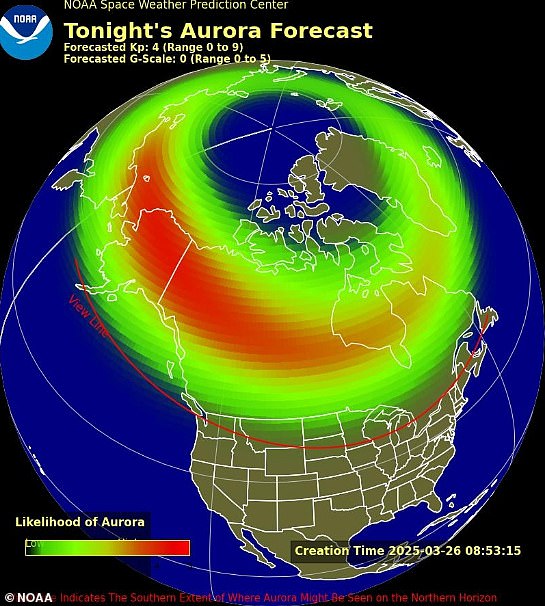Brits have been told to keep an eye on the skies tonight as there‘s a chance they may be able to spot the Northern Lights.
Also known as the aurora borealis, the colourful light show turns the sky various fluorescent shades.
The Met Office says the aurora is due to a ‘high speed stream’ (HSS) emitted from a coronal hole – an opening in the sun’s outer surface.
Although it’s not an exact science, generally the further north you are, the greater the probability of you witnessing the aurora borealis.
In the UK, people in Scotland are best-placed, but there may also be naked eye viewings as far south as Newcastle and Belfast.
And if you’ve got a decent camera on your phone, you should be able to capture shots of the aurora even if you cannot see it yourself.
Already, Brits have snapped photos of the aurora in the small hours of Wednesday – and experts say it should appear again tonight.
‘Cameras help as the long exposure allows loads of light in and enhances the colours more than the human eye can see,’ a Met Office spokesperson said.

If you’ve never witnessed the awesome natural spectacle that is the Northern Lights, tonight you may finally get your chance

Aurora Watch said it is ‘likely’ Brits may be able to see the lights tonight

Experts say the natural light show, also known as the aurora borealis, should be visible on Wednesday night due to ‘enhanced solar activity’. Pictured, aurora at St Mary’s lighthouse in Whitley Bay in the early hours of Wednesday

The further north you are, the greater the probability of you witnessing the aurora borealis
‘That is why you see pictures as far south as Cornwall sometimes though you’re unlikely to see it with the naked eye that far south.’
According to the Met Office, the aurora is best viewed across northern Scotland, with a ‘slight chance’ of sightings across southern Scotland and similar latitudes.
There’s a chance of some visibility further south tonight, possibly in the far north of England, though for best viewing you’re likely to need to use a long exposure shot on a camera, a spokesperson told MailOnline.
However, visibility will be obscured for many, with rain and cloud in the forecast, especially for those in western and central areas of Scotland overnight.
Looking into Thursday night, sightings over northern parts of the UK remain possible, though cloud and rain will once again obscure viewing potential for many.
‘Heavy rain and cloud gradually moves from the northwest gradually southeast on Thursday night,’ said the spokesperson.
‘This means viewing will be obscured for many, with perhaps the best chance in the north of Scotland, once the front has cleared the area.’
Aurora can often be observed somewhere on Earth from just after sunset or just before sunrise, but are not visible during daylight hours.

A Met Office animation shows tonight’s auroral oval – the ring-like range of auroral activity that determines the range of the Northern Lights and where it will be most visible

The aurora borealis, also known as the northern lights, light up the sky over a farmer’s grain bins near Herronton, Alberta, Canada October 7, 2024

In the Earth’s north, the Northern Lights are officially known as the aurora borealis, while in the south, the event is called aurora australis. Pictured, aurora australis as it glows on the horizon over the waters of Lake Ellesmere on the outskirts of Christchurch on October 8, 2024
The best way to see the stunning displays is to find a dark place, away from light pollution such as street lights and ideally a cloud-free sky.
Some of the best aurora spots around the UK are in areas of high elevation (closer to the magnetosphere) and away from cities that pollute the sky with artificial light.
This latest aurora may also be viewable on Thursday and Friday night as well due to the ‘high speed stream’ (HSS) from the coronal hole.
Coronal holes are darker, cooler and less dense regions on the corona (the outermost part of the sun’s atmosphere).
From these holes, high speed solar wind streams – made up of highly-charged particles – can escape at about 1 million miles per hour.
When they reach Earth, the charged particles travel down the magnetic field lines at the north and south poles into our planet’s atmosphere.
There, the particles interact with gases in our atmosphere, resulting in beautiful displays of light in the sky, known as auroras.
The colour display depends in part on what molecules the charged particles interact with; red and green colours tend to be hallmarks of oxygen, pink and red the signs of nitrogen with blue and purple being the results of hydrogen and helium.

Northern lights in the sky over trees along the Inuvik-Tuktoyaktuk Highway, north of Inuvik, Northwest Territories, Canada, February 28, 2025

If you’ve always dreamed of seeing the Northern Lights, tonight could be your opportunity. Here, the aurora borealis illuminates the sky in Alaska, US on October 7, 2024

The National Oceanic and Atmospheric Administration (NOAA) has rated it ‘G0’ (on a scale of one to five) meaning it will be will be far north, quite dim in intensity and not very active
In North America, there’s a reduced chance of seeing the aurora tonight, although people in Canada and Alaska may catch a glimpse.
The National Oceanic and Atmospheric Administration (NOAA) has rated it ‘G0’ (on a scale of one to five) meaning it will be will be far north, quite dim in intensity and not very active.
Meanwhile, in the southern hemisphere – where it’s known as aurora australis – the spectacle could be seen across Tasmania and Southern New Zealand in clear skies.
Although not dangerous to humans, the particles can damage power grids on Earth and satellites in orbit, which can lead to internet disruptions.
‘Harmful space weather has affected Earth before, but as we become increasingly reliant on systems and technologies vulnerable to the Sun’s outbursts, future solar impacts could be even more disruptive,’ says the European Space Agency (ESA).











